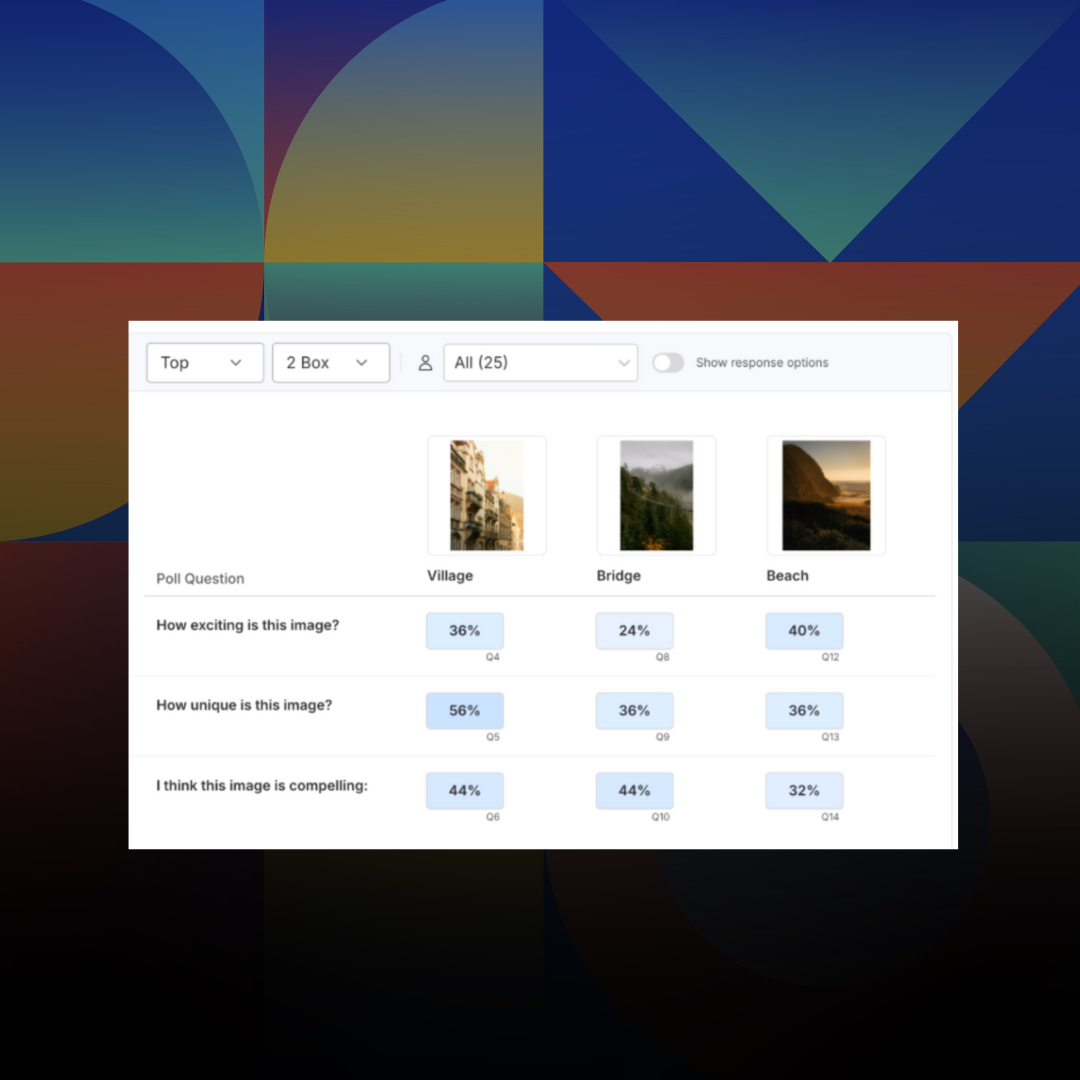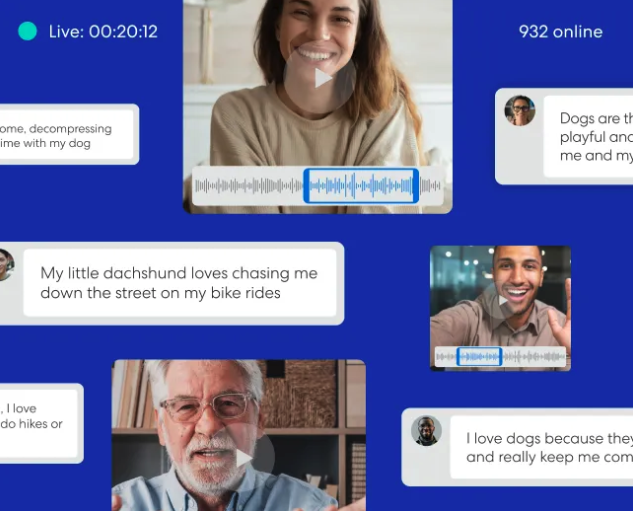
Advanced Research
The Most Cutting-Edge Consumer Insights Software of 2026
Team Remesh
January 5, 2026
Market Research
Articles

Advanced Research
The Most Cutting-Edge Consumer Insights Software of 2026
Team Remesh
January 5, 2026
Market Research
Articles

Research 101
Introducing: Poll Comparison - Streamline Concept Testing and Make Better Decisions Faster
Emmet Hennessy
November 24, 2025
Market Research
Articles

Research 101
Introducing: Poll Comparison - Streamline Concept Testing and Make Better Decisions Faster
Emmet Hennessy
November 24, 2025
Market Research
Articles

AI
Purpose-Built for Research AI is Here - a Letter from the CPO
Jessica Dubin
October 21, 2025
Market Research
Articles

AI
Purpose-Built for Research AI is Here - a Letter from the CPO
Jessica Dubin
October 21, 2025
Market Research
Articles

Advanced Research
Unlock Agile Global Insights: Using Remesh Multi-Language Conversations for Research Across Audiences
Customer Success Team
October 14, 2025
Market Research
Articles

Advanced Research
Unlock Agile Global Insights: Using Remesh Multi-Language Conversations for Research Across Audiences
Customer Success Team
October 14, 2025
Market Research
Articles

AI
The Prompt Is the New Moderator Guide
Anthony Lam
September 16, 2025
Market Research
Articles

AI
The Prompt Is the New Moderator Guide
Anthony Lam
September 16, 2025
Market Research
Articles

AI
Building an AI-Ready Research Stack: Beyond Data Preparation
Anthony Lam
September 9, 2025
Market Research
Articles

AI
Building an AI-Ready Research Stack: Beyond Data Preparation
Anthony Lam
September 9, 2025
Market Research
Articles

AI
Agentic AI for Research: A Practical Primer
Dan Reich
September 2, 2025
Market Research
Articles

AI
Agentic AI for Research: A Practical Primer
Dan Reich
September 2, 2025
Market Research
Articles
5 Ways Voice Recognition Technology Sways Consumer Buying Behavior
Since Google released voice search for iPhones in 2008 - a move that popularized consumer use of voice technology for the first time, well before Siri - voice-recognition technology has seen exponential expansion.



Since Google released voice search for iPhones in 2008 - a move that popularized consumer use of voice technology for the first time, well before Siri - voice-recognition technology has seen exponential expansion. With what started primarily in larger companies such as Google and Amazon has now spread across every industry. This trend will solidify as brands try to keep up with customer demand.
The main force driving the expansion of voice technology is the change in consumer preferences. Since their early release (notably from Google assistants and Apple products), consumers have become far more comfortable with devices such as smart speakers and virtual assistants. In fact, one estimate predicts that 8 billion digital voice assistants will be in use by 2023. That’s up from the 2.5 billion assistants in use at the end of 2018.
Because voice assistants are increasingly common, consumers feel more comfortable engaging in an A.I.-powered conversation. This is especially true when engaging in purchasing tasks like grocery shopping. The influx of voice technology started in personal devices like cell phones. Now, consumers can purchase voice-powered heating and cooling systems for their homes, speakers that follow voice commands, and other smart appliances.
What’s Next for Voice Technology and A.I.?
Each improvement in A.I. technology is geared toward enhancing the user experience. Features are becoming more personalized and data is becoming more personal. As technology continues to advance, voice-powered A.I. will offer users a faster customer experience (and shorter customer lifecycle) than screen-powered devices.
New voice recognition software is expanding beyond serving a single function. Voice tech can be used as a hub between several smart devices in an effort to optimize the experience for consumers.
1. Smart home devices will be streamlined
Streamlining and compatibility among existing voice-powered devices will inspire new product growth with the goal of monopolizing a customer’s daily activity. To do this, more companies will develop voice technology products that act as a hub between several home devices and appliances.

(Source: MarketSource)
Amazon has been an early innovator of the compatibility initiatives in tech. Users of Amazon’s Alexa, for example, can integrate their device with a vast array of products like the Samsung Family Hub. This package of devices include a refrigerator that tracks family food preferences, shopping lists, and low inventory. Software like Google Voice will continue to develop as well, maintaining a family’s schedule and calendar.
2. The Growth of Google Assistant, Alexa, and Siri
For companies, the rise of A.I.-powered voice search poses a variety of challenges. First, companies face the absence of a visual interface. Existing products (such as Google Home or Amazon Echo) have no visual features. Therefore, voice technology has no visual real estate for marketers and advertisers to strategize (or visually advertise) their products.
As a result, voice tech could open up a market of paid advertising on personal assistants. Brand visibility will rely on listening points/speech recognition from consumers to optimize their marketing strategies. Although currently dominated by tech industry leaders, these marketing strategies could bring new advertising avenues for small businesses to grow. These marketing opportunities will increase in demand as more consumers continue to gravitate toward using smart assistants.
Of users who own/interact with a voice-powered speaker, 52% would like to receive information and promotion from brands. In addition, nearly half of users would also like to receive personalized tips from brands to make their lives easier.
With the increase of search volume by voice, brand visibility is shifting. Companies have to adapt to the new trends in voice search to optimize their brand visibility on search engines. By 2020, at least 50 percent of all searches will be done via voice technology.

(Source: Voicebot)
Put simply, customers don’t type the way they talk. Speech-to-text translations are typically inaccurate on new or underdeveloped technologies. In addition, technologies have seen their own learning curves in detecting voices in places with distractions and background noise. As products develop, more of these barriers are being broken down to optimize the experience for users.
3. Voice Commands Will Revolutionize At-Home Surveys
Users are becoming more comfortable sharing their product opinions on voice-powered platforms. This concept has inspired the rise of the talking survey. If brands investigate customer feedback through personal assistants, consumers will likely give responses in the comfort of their own homes. The common use of this method would revolutionize diary surveys, where consumers track their habits and behaviors in a paper diary or Excel sheet.
This method could also optimize customer feedback collection. Companies conducting research will be able to strategize their data collection in entirely new ways. Surveys will feel much less like an interrogation, and more like a conversation.
As a result, brands will be able to more effectively target their customer personas through voice than through screen time.
4. Voice Assistants Will Become More Like You
With recent developments in artificial intelligence, internet technology has been able to store incredible amounts of metadata to understand consumer preferences. In a similar way, voice technology will be able to store the same metadata from voice interactions, and build that data into customer personas.
The current streamlining of compatible devices gives users the opportunity to customize many features that change how they carry out daily tasks. For example, users are able to ask “What’s on my calendar today?” and receive a rundown of upcoming activities. Or, users can ask questions similar to a Google search, like “What’s the weather looking like this afternoon?”
However, with shared devices, multiple users can’t be understood at the same time. The development of speech recognition software will allow for personal assistants to differentiate between voices on shared or family devices.
In addition to developing a deeper understanding of human voice, the tech itself is becoming more human-like. According to thought leaders like Ray Kurzweill, the humans and A.I. systems will one day be indistinguishable.
5. Digital Assistants Will Guard Your Data Privacy
Voice search has been a popular topic of discussion for the future of A.I. ethics. As consumers become more comfortable with voice recognition technology, the data they reveal to these devices becomes more personalized, and therefore more sensitive.
The ways that companies handle personalized data will shape the future of A.I. ethics. The rise of digital payment forms, the ability to store banking information on personal devices, and the existence of digital marketplaces are all risk opportunities.
More than 50 percent of people who own a voice technology speaker say they feel natural talking to it. This shift means consumers may feel more comfortable sharing information than ever before.

(Source: Donald Koo)
Purchasing products with voice technology will make for an easier, hands-free customer experience. It will also push the use of voice verification and speaker I.D. in order to prevent fraud.
Voice-powered technology and consumer habits
The next stage of advancement for A.I. powered voice technology? Not just understanding what users are saying, but how users are saying it.
Some 62% of customers who own and use a voice-powered speaker report they will make a purchase by voice within the next month. Consumers will become more comfortable shopping with voice-powered A.I. systems as usage becomes more common. This will fundamentally change the ways that humans interact with smart devices.
{{cta('f4128950-c633-470c-9298-5c9fc18b0a4a','justifycenter')}}
-
Lorem ipsum dolor sit amet, consectetur adipiscing elit. Suspendisse varius enim in eros elementum tristique. Duis cursus, mi quis viverra ornare, eros dolor interdum nulla, ut commodo diam libero vitae erat. Aenean faucibus nibh et justo cursus id rutrum lorem imperdiet. Nunc ut sem vitae risus tristique posuere.
-
Lorem ipsum dolor sit amet, consectetur adipiscing elit. Suspendisse varius enim in eros elementum tristique. Duis cursus, mi quis viverra ornare, eros dolor interdum nulla, ut commodo diam libero vitae erat. Aenean faucibus nibh et justo cursus id rutrum lorem imperdiet. Nunc ut sem vitae risus tristique posuere.
-
More


Introducing: Poll Comparison - Streamline Concept Testing and Make Better Decisions Faster

.png)

.png)
Read More

.png)
.png)
.png)

.png)

.png)
Learn More

.png)
.png)
.png)

Stay up-to date.
Stay ahead of the curve. Get it all. Or get what suits you. Our 101 material is great if you’re used to working with an agency. Are you a seasoned pro? Sign up to receive just our advanced materials.






